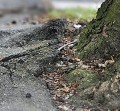Can’t Reduce Emissions? Find Some Other Way To Screw It Up.
Posted by keith on September 4th, 2009
Civilization has singularly failed to reduce its emissions, and so the planetary climatic, oceanic and biological systems are running into repeated and major tipping points, plunging us into increasingly dire trouble. No, this is not the future, this is now – there is nothing we can do about the greenhouse gases that Industrial Civilization has so far poured into the atmosphere, and there is very little indeed we can do to reverse the widespread effects of deforestation, marine ecosystem plundering and the multitude of different persistent chemicals currently polluting the food chain.
But we can stop things getting worse than they might. According to the Royal Society, what we need to do is to geoengineer the climate. The following story from The Independent outlines the “Plan B” project that is being drawn up by the Royal Society; see what you think:
Some of Britain’s most distinguished scientists have put their names behind controversial proposals to engineer the global climate with highly ambitious technology projects if international attempts to control man-made emissions of greenhouse gases show serious signs of failing.
The Royal Society, the UK’s national academy of sciences, has warned that if political leaders fail to reach agreement and enforce a significant reduction in carbon dioxide emissions following the climate conference in Copenhagen this December there may be no other option left than to introduce drastic measures involving the “geo-engineering” of the global climate.
A group of eminent scientists appointed by the Royal Society said in a report published yesterday that future efforts to reduce greenhouse gases needed to be much more successful than they had been so far if geo-engineering was to be avoided as a way of cooling a dangerously overheated planet.
“Geo-engineering the Earth’s climate is very likely to be technically possible. However, the technology to do so is barely formed, and there are major uncertainties regarding its effectiveness and environmental impacts,” the report says.
Geo-engineering projects range from schemes to fertilise marine plankton with iron powder to injecting sulphate particles into the atmosphere in order to simulate the cooling effects of volcanic eruptions. All are controversial and none are without some risk but they should nevertheless be taken seriously if conventional measures to limit carbon dioxide emissions fail to stop potentially dangerous climate change, the Royal Society said.
Professor John Shepherd, an earth scientist at the National Oceanography Centre in Southampton, who chaired the Royal Society’s working group, said that geo-engineering had to be prepared as a backup in case the “plan A” discussed in Copenhagen fails. “[Geo-engineering] is a plan B, but a very real plan B that has to be taken seriously,” Professor Shepherd said.
“It is an unpalatable truth that unless we can succeed in greatly reducing carbon dioxide emissions we are headed for a very uncomfortable and challenging climate future, and geo-engineering will be the only option left to limit further temperature increases,” Professor Shepherd said.
“Our research found that some geo-engineering techniques could have serious unintended and detrimental effects on many people and ecosystems yet we are still failing to take the only action that will prevent us from having to rely on them,” he said. “Geo-engineering and is consequences are the price we may have to pay for failing to act on climate change.”
The report recommended that Britain should spend £10m a year on research into geo-engineering schemes, which is about a tenth of the Government research budget on climate change.
The Royal Society’s report, which took 18 months to prepare, was welcomed by Professor John Beddington, the Government’s chief scientific adviser, who said that it was time to treat geo-engineering seriously. “Some kind of modest investment in geo-engineering is what we should be thinking about now,” Professor Beddington said.
“There are going to be emergencies that we did not expect and we need to think about how to deal with them. Geo-engineering techniques are not the solution but they are part of the solution.”
In the past decades, geo-engineering has gone from almost pariah status to a subject that scientists can talk about in public without fear of ridicule. However, many climate scientists are worried that political leaders will use the debate to suggest that there is a workable alternative to deep and painful cuts in carbon dioxide emissions.
“Geo-engineering is creeping on to the agenda because governments seem incapable of standing up to the vested interests of the fossil fuel lobby who will use it to undermine the emissions reduction we can do safely,” said Doug Parr, from Greenpeace. “Intervening in our planet’s systems carries huge risks.”
‘Plan B’: The weapons in science’s armoury
Spraying seawater into the air to generate clouds and injecting sulphate into the atmosphere to simulate the cooling effects of volcanic explosions are two geo-engineering ideas considered by Britain’s leading scientific body. A Royal Society report defines geo-engineering as the deliberate, large-scale manipulation of the environment to counteract climate change caused by greenhouse gas emissions.
The report divides geo-engineering schemes into two categories: techniques to remove carbon dioxide from the air to counterbalance emissions directly, and projects to offset the warming effects of increased greenhouses gases by reflecting sunlight into space. In terms of solar radiation, the report reviews ideas ranging from painting roofs white to space-based mirrors. It says these technologies are cheaper and faster-acting than carbon dioxide removal but have several drawbacks: they don’t address the root cause of global warming or ocean acidification.
It says methods to remove carbon dioxide would be preferable to solar radiation management methods, because “they effectively returned the climate system to closer to its natural state” and involved fewer uncertainties and risks. The problem with many carbon-reduction schemes that do not involve reforestation is that they are largely unproven and expensive. One idea is the enhanced weathering of silicate rocks, a natural process where carbon dioxide in the air reacts with silicate minerals to form carbonate rocks which effectively trap the gaseous carbon dioxide. Another is the capture of carbon dioxide by devices that can filter the air, perhaps using solar energy to power the process.
A variation on this theme is the proposal to fertilise the oceans with iron to stimulate algal blooms that could in theory capture carbon dioxide and convert it to solid material which would fall to the seabed. But the Royal Society warned of that project’s possible unintended consequences for the marine environment.
Let’s get this straight, as Doug Parr said, geoengineering is an excuse for corporations and governments to do nothing. Worse than that, by producing this report the Royal Society have, in effect, announced that “even” if business and governments don’t manage to reduce emissions sufficiently (which they obviously have no intention of doing), there is something waiting to take up the slack at the end of the rainbow. Cue even more reasons for everyone to do absolutely nothing – hooray, technology will save the day!
It is important to stress the comments in this article, by Royal Society members, about the inherent dangers of geoengineering — they cannot be stated strongly enough:
“Geo-engineering the Earth’s climate is very likely to be technically possible. However, the technology to do so is barely formed, and there are major uncertainties regarding its effectiveness and environmental impacts”
“Our research found that some geo-engineering techniques could have serious unintended and detrimental effects on many people and ecosystems yet we are still failing to take the only action that will prevent us from having to rely on them”
But those, deeply important statements will be conveniently swept under the carpet when the shit hits the fan, as suggested by John Beddington, Chief Scientist for UK Government Incorporated. And the Royal Society themselves are so obviously in thrall to the lie that there is only one way to live, as evidenced by the statement: “geo-engineering will be the only option left to limit further temperature increases”.
So, when I said at the beginning of this piece that we could stop things getting worse than they might, what was I thinking about? Certainly not geoengineering, which is the last catastrophic hoorah! in the civilized world’s great toxic party. Something far more radical in civilised terms, yet completely logical:
Getting rid of Industrial Civilization.
If you consider the alternative, then that doesn’t sound too bad at all, does it?






September 6th, 2009 at 12:14 pm
I just found your site (A matter of scale) and will look at your book.
I am curious what you want your logo to portray.
I see a fat, white, oversized male creeping over the earth dirtying (all parts under him are black) it as he goes. He reaches out to the blue/green parts but doesn’t quite make it.
Clearly, he is out of scale.
[Hi ET, probably not the right place to talk about this, but just to clarify, it is a baby / very young child of indeterminate gender crawling around the Earth to escape the industrial world in order to reach something better – under him/her is the spreading toxic influence of civilization. You are the first person to suggest an alternative, but if you want that image then feel free. Enjoy the book. K.]
September 7th, 2009 at 11:31 pm
Yes, geoengineering is a ridiculous idea. So is the upcoming U.S. Senate climate change bill that will undoubtably have the same bogus solutions as the House ACESA bill…including $10 billion for risky carbon capture and sequestration. That’s why a diverse group of climate and social justice activists and environmental activists are touring the U.S. this week to get the word out. Check us out. We’d love to hear from you. Contact Duff at 206-619=6304.
GRASSROOTS GROUP TOURS
TO DEFEAT CLIMATE BILL
• Climate SOS Tours to “Kill The Bill” and push tougher laws
• “Worse Than Nothing is Not Good Enough”
Climate SOS, a grassroots network of environmentalists, scientists, and social justice activists, is launching a nationwide car-free tour to defeat the climate bill now being considered in the Senate—and to demand that any new legislation be grounded in science instead of politics. http://www.climatesos.org/
The Climate SOS Heartland Tour will feature meetings with senate staffers in North Dakota, Indiana, Arkansas, and Ohio. Climate SOS organizer Duff Badgley, traveling exclusively by bus and train, will touch down in Bismarck on September 8, in Indianapolis (September 10-11), Little Rock (Sept. 14-15), and Cleveland (Sept. 17-18). His message? “Kill the Bill—Worse Than Nothing is Not Good Enough!”
Climate scientist Dr. James Hansen has personally endorsed the Climate SOS campaign.
According to Hansen, if the senate climate bill is based upon the house-passed American Clean Energy and Security Act (ACESA), it will be “worse for the environment than doing nothing.”
Climate SOS maintains that cap-and-trade will be ineffective in forestalling climate change, and supports EPA authority over carbon dioxide emissions. The group opposes the use of carbon offsets and believes that polluting coal plants should be phased out quickly. Climate SOS asserts that incineration technologies must not be categorized as “renewable,” and targets loopholes in the bill that allow unlimited carbon dioxide emissions from biomass and trash burners. (Call to Action here)
Climate SOS holds that social justice concerns must be central to any climate legislation, and maintains that the federal climate bill currently under consideration would:
• Prevent the U.S. from making its fair share of greenhouse gas reductions—reductions necessary to forge an effective global strategy on climate stabilization and to avert catastrophic climate change.
• Lock the United States into a complex cap-and-trade scheme that benefits fossil fuel utilities, Wall Street, and agribusiness. Cap and trade will be prone to Enron-style market manipulations, while doing nothing to save the climate.
• Use public money to subsidize the most polluting industries, drawing much needed financing away from real climate solutions.
• Add more polluting smokestacks, especially in backyards of the poor, people of color, and indigenous communities across the U.S., by grandfathering dirty old coal plants, permitting numerous new ones, and subsidizing incinerators as a form of renewable energy
• Trigger rainforest destruction in Africa, the Amazon, and Southeast Asia through its failure to incorporate indirect land use change provisions in the Renewable Fuel Standards (RFS) for biofuels.
Contacts:
Duff Badgley, Founder, One Earth Climate Action Group
duff@climatesos.org
206.283.0621 (o)
206-619-6304 (c)
Rachel Smolker, Co-director, Biofuelwatch
802.482.2848 (o), 802.735.7794 (m)
rsmolker@riseup.net
Robert Jereski, Co-founder, New York Climate Action Group
212.973.1782
mutualaid@earthlink.net
Maggie Zhou, Massachusetts Coalition for Healthy Communities
781.316.8283
maggie@securegreenfuture.org